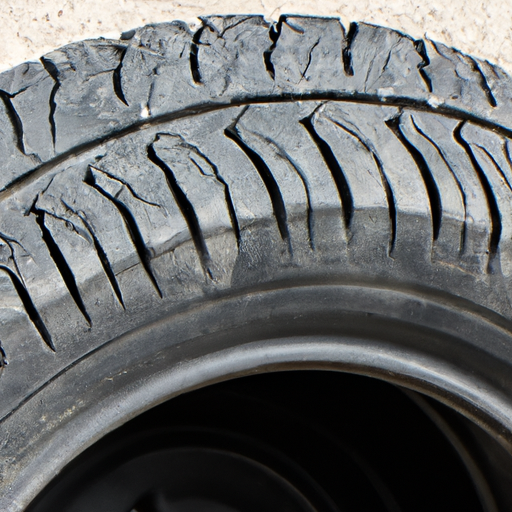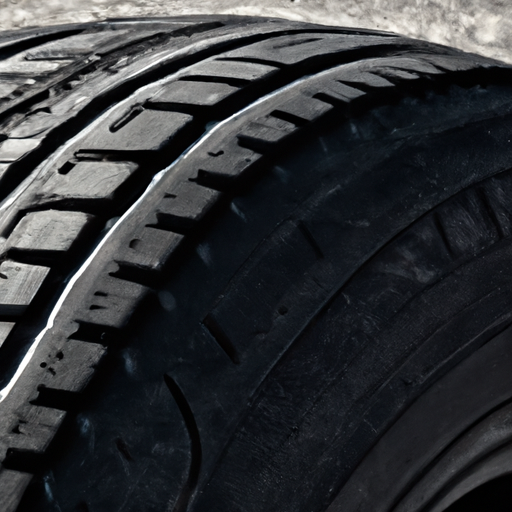Hot summer days may be synonymous with beach trips and ice cream cones, but they can also take a toll on your tires. The scorching heat can cause summer tires to wear out faster, leading to decreased performance and potential safety risks. In extreme heat conditions, the rubber compounds in summer tires can become softer, compromising their durability and lifespan. As temperatures rise, it’s essential to pay attention to your tires and ensure they are in optimal condition to keep you safe on the road.
The Purpose of Summer Tires
Definition and Characteristics
Summer tires, also known as performance tires, are designed to provide optimal traction and handling on dry and wet road surfaces during the warm summer months. These tires are made from a unique rubber compound that remains flexible and grippy at high temperatures, ensuring excellent responsiveness and control. They typically have a shallower tread depth and fewer grooves compared to all-season or winter tires, allowing for maximum contact with the road for improved cornering and braking performance.
Benefits of Using Summer Tires
Using summer tires during the appropriate season offers several benefits. Firstly, their specialized rubber compound enhances grip and traction on hot and dry roads, providing better handling and maneuverability. This improved grip translates to shorter braking distances, which can be crucial for avoiding accidents. Summer tires also excel in wet conditions, thanks to their optimized tread pattern that efficiently channels water away from the contact patch, reducing the risk of hydroplaning.
Moreover, summer tires offer enhanced stability and precise steering response, delivering a more enjoyable and comfortable driving experience. They provide superior cornering capabilities, allowing you to navigate curves with confidence and maintain control even at higher speeds. Additionally, these tires typically offer reduced rolling resistance compared to all-season tires, leading to improved fuel efficiency and lower carbon emissions.
Understanding Tire Wear
Factors Affecting Tire Wear
Tire wear is influenced by various factors, including driving habits, road conditions, maintenance practices, and the tire’s construction. Aggressive driving, such as hard braking and acceleration, can accelerate tire wear. Similarly, frequently driving on rough or poorly maintained roads can lead to increased wear. Additionally, improper tire maintenance, such as neglecting to rotate and balance the tires regularly or failing to maintain the recommended tire pressure, can contribute to uneven wear patterns.
Tread Life Expectancy
Tire manufacturers typically provide an estimated tread life expectancy for their products. However, it is essential to note that this estimate can vary based on the aforementioned factors affecting tire wear. Summer tires tend to have shorter tread life compared to all-season tires due to their softer rubber compound. As a result, they may require more frequent replacement to maintain optimal performance and safety.
Driving Habits and Maintenance
Your driving habits play a significant role in tire wear. Smooth and controlled driving, avoiding sudden stops and aggressive maneuvers, can help prolong the life of your summer tires. Additionally, proper tire maintenance is crucial. This includes regular tire inspections to identify any signs of wear or damage, maintaining the recommended tire pressure, rotating the tires periodically, and keeping the tires properly aligned and balanced.

The Impact of Heat on Tire Wear
How Heat Affects Tire Performance
Extreme heat can have significant effects on tire performance. High temperatures cause the air inside the tire to expand, increasing the tire pressure. This increase in pressure can impact the tire’s contact patch with the road and potentially lead to decreased traction and handling capabilities. Heat also accelerates the chemical aging process of the tire, causing the rubber to deteriorate and potentially reducing its overall lifespan.
Tire Deformation in Extreme Heat
Prolonged exposure to extreme heat can cause tire deformation. When a tire becomes excessively hot, the rubber compound softens and loses its stability, leading to bulging or blistering on the sidewalls. These deformations not only compromise the tire’s structural integrity but also affect its performance, resulting in decreased handling, steering response, and overall safety.
Increased Rolling Resistance
Extreme heat can also increase the rolling resistance of tires. As the temperature rises, the rubber compound becomes stickier, resulting in higher friction between the tire and the road surface. This increased rolling resistance can lead to reduced fuel efficiency, requiring the engine to work harder and consuming more fuel. It is important to note that excessive rolling resistance can also generate more heat, further contributing to tire wear and potentially causing blowouts or tire failure.
Accelerated Tread Wear
In extreme heat conditions, the combination of high temperatures and road friction can expedite tread wear. The heat softens the rubber compound, making it more susceptible to abrasion from the road surface. This accelerated wear can lead to premature tread depth reduction, reducing traction, and compromising the tire’s ability to effectively displace water on wet roads.
Effect of Extreme Heat on Tire Pressure
Expansion of Air in Tires
One of the primary effects of extreme heat on tires is the expansion of air inside the tire. As the temperature rises, the air molecules within the tire gain energy and move more rapidly, increasing the pressure inside the tire. This expansion can have consequences on the tire’s performance and safety.
Higher Temperatures and Increased Pressure
When tire pressure exceeds the recommended levels due to extreme heat, it can negatively affect the tire’s contact patch with the road. Overinflated tires have a reduced contact area, leading to compromised traction and handling. The increased pressure can also result in a harsher ride quality and decreased comfort.
Potential Risks of Overinflation
Overinflated tires are more susceptible to damage from potholes, bumps, and other road imperfections. The excess air pressure increases the likelihood of impact damage and reduces the tire’s ability to absorb shocks. This can result in sidewall bulges, tire punctures, or even a blowout, compromising your safety on the road.
Monitoring Tire Pressure in Hot Conditions
To mitigate the effects of extreme heat on tire pressure, it is crucial to regularly monitor and adjust tire pressure. Check the tire pressure when the tires are cold, preferably before driving or when they haven’t been exposed to direct sunlight for an extended period. Refer to the vehicle manufacturer’s recommendations or the tire manufacturer’s guidelines for the recommended pressure levels. Additionally, use a reliable tire pressure gauge to ensure accurate readings and maintain the optimal pressure for your specific tires.

Heat-Related Tire Damage
Thermal Degradation
Extreme heat can cause thermal degradation in tires, leading to a deterioration of their structural integrity and performance. Prolonged exposure to high temperatures can accelerate the aging process of the rubber compound, resulting in the loss of elasticity and increased brittleness. This degradation can weaken the tire’s structure and compromise its ability to provide optimal traction, handling, and safety.
Effects on Tire Compound
The intense heat can cause the tire’s rubber compound to harden and lose its flexibility, negatively impacting its ability to conform to the road surface. This reduced flexibility reduces grip and traction, affecting braking distances and cornering capabilities. The degraded rubber compound may also become more prone to cuts, punctures, and cracks, further compromising the tire’s overall performance and safety.
Cracking and Dry Rot
Extreme heat can accelerate the development of cracks and dry rot in tires. Cracks can form on the sidewalls, tread, or shoulders of the tire, compromising its structural integrity. Dry rot refers to the deterioration of the tire’s internal structure, which can lead to bulges, separation of layers, and ultimately tire failure. Regular inspections and proper tire maintenance can help detect these signs early and prevent potential hazards on the road.
Bulges or Blisters on Tire Sidewalls
Heat-related tire damage can manifest as bulges or blisters on the sidewalls. Excessive heat can cause the internal components of the tire to separate or shift, creating abnormal bulges or blisters on the sidewalls. These bulges are a clear indication of potential tire failure and should be addressed immediately. Continuing to drive on a tire with visible bulges or blisters poses a significant risk of a blowout, which can result in a loss of control and potentially cause an accident.
Mitigating Tire Wear in Extreme Heat
Regular Tire Inspections
Regular tire inspections are crucial, particularly when driving in extreme heat conditions. Inspect the tires visually for signs of wear, such as uneven tread wear, cracks, bulges, or blisters. Ensure that the tires are properly inflated to the recommended pressure levels and inspect the tread depth regularly. If you notice any abnormalities, consult a professional tire technician for a detailed inspection and necessary maintenance or replacement.
Proper Inflation and Maintenance
Maintaining the recommended tire pressure is essential in extreme heat to optimize tire performance and minimize wear. Monitor the tire pressure regularly, especially during extended periods of hot weather. Consult the vehicle manufacturer’s recommendations or the tire manufacturer’s guidelines for the appropriate pressure levels. Also, adhere to scheduled tire maintenance tasks, such as rotation, balance, and alignment, to promote even wear and prolong tire life.
Using Heat-Resistant Tires
Consider using tires specifically designed for high-temperature environments. Heat-resistant tires utilize advanced rubber compounds that can withstand and dissipate heat effectively, reducing the risk of accelerated tire wear. Consult with tire professionals or refer to manufacturers’ specifications to ensure that you select tires suitable for your vehicle and the prevailing weather conditions.
Adjusting Driving Habits
Adapting your driving habits in extreme heat can help mitigate tire wear. Avoid aggressive maneuvers, such as hard braking or accelerating, as these actions generate additional heat and can lead to accelerated tire wear. Maintain a safe distance from other vehicles to reduce the need for sudden stops. Smooth and controlled driving promotes even distribution of forces on the tires, reducing wear and extending their lifespan.

Tire Selection Considerations
Choosing the Right Summer Tire
When selecting summer tires, consider factors such as your geographical location, driving style, road conditions, and the expected temperature ranges during the summer season. Look for tires that offer excellent traction, handling, and wet grip performance. Manufacturers often provide detailed information regarding tire specifications, including temperature ratings, tread patterns, and performance characteristics. This information can guide you in choosing the most suitable summer tires for your vehicle.
Identification of Heat-Resistant Tires
To identify heat-resistant tires, look for indications such as “summer tires” or “high-temperature performance” in the tire’s description or labeling. Additionally, manufacturers may specify the tire’s maximum operating temperature or provide information about the tire’s ability to dissipate heat efficiently. Consulting with tire experts or reading professional reviews can also help in identifying and selecting heat-resistant tires.
Tire Performance Ratings
Consider tire performance ratings when evaluating different summer tire options. Ratings such as traction, temperature resistance, and treadwear can provide insights into potential tire performance and durability. These ratings are assigned by independent organizations and provide a standardized way to compare tires from different manufacturers. Prioritize tires with high ratings in the relevant categories for optimal performance in extreme heat conditions.
Professional Recommendations
Consulting with tire professionals, such as tire dealers, mechanics, or specialists, can provide valuable insights into the most suitable tires for your specific needs and driving conditions. These professionals have expertise in understanding tire specifications, performance characteristics, and compatibility with various vehicles. Seek their recommendations to ensure that you make an informed tire selection that meets your safety and performance requirements.
Tire Maintenance Tips for Hot Weather
Driving with Care
In hot weather, it is crucial to drive with care and be mindful of potential tire-related issues. Maintain a safe and moderate speed, avoiding aggressive maneuvers that can generate excessive heat and increase tire wear. Be cautious when encountering potholes, road debris, and other hazards, as extreme heat can make tires more susceptible to damage.
Avoiding Overloading
Overloading your vehicle can place excessive stress on the tires, leading to accelerated wear and potentially jeopardizing your safety. Consult your vehicle’s owner’s manual or the tire manufacturer’s load rating to determine the maximum weight capacity for your vehicle. Avoid exceeding this capacity and distribute the load evenly to minimize strain on the tires.
Parking Precautions
When parking during hot weather, consider the surface on which you are parking. Avoid parking on asphalt or any surface that absorbs and retains heat, as this can increase the already high temperatures experienced by the tires. Whenever possible, park in shaded areas or use sunshades to minimize direct exposure to sunlight. This can help mitigate heat-related tire damage and preserve tire integrity.
Storage Recommendations
If you are storing your vehicle during the summer months, take proper precautions to preserve the condition of the tires. Ensure that the tires are properly inflated to the recommended pressure levels before storage. Clean the tires thoroughly and apply a protective tire dressing to prevent drying and cracking. If storing the vehicle for an extended period, consider using tire cradles or jacks to relieve the weight on the tires and prevent flat spots.

Proper Tire Storage in Hot Climates
Ideal Storage Conditions
When storing tires in hot climates, it is essential to create the ideal storage conditions that minimize the impact of heat on the tires. Store the tires in a cool, dry, and well-ventilated area, away from direct sunlight or other heat sources. Excessive heat can accelerate tire degradation even when not in use, so it is crucial to maintain an environment with a stable and moderate temperature.
Avoiding Exposure to Sunlight
Direct exposure to sunlight can cause the rubber compound to deteriorate faster, leading to premature tire aging and decreased performance. Store the tires indoors or use tire covers to shield them from UV rays. If stored outdoors, ensure that the tires are protected by durable covers specifically designed for this purpose.
Temperature and Humidity Considerations
Storing tires in an environment with stable temperature and humidity levels is essential. Extreme heat and high humidity can affect the integrity of the tire’s rubber compound, potentially leading to dry rot, cracking, and other forms of damage. Aim for a storage area with a temperature range between 50 to 70 degrees Fahrenheit (10 to 21 degrees Celsius) and a humidity level between 35% to 50%.
Tire Covering and Stacking Techniques
When storing multiple tires, avoid stacking them directly on top of each other without any protective measures. Placing a piece of clean plywood or a tire rack between the stacked tires can help distribute the weight evenly and prevent deformation. Additionally, avoid using plastic or vinyl covers, as they can trap moisture and contribute to the growth of mold or mildew. Instead, opt for cloth or canvas covers that allow proper ventilation.
Conclusion
Final Thoughts
As the temperature rises during the summer season, it is essential to understand the impact of extreme heat on tire wear. Using summer tires designed specifically for warm weather conditions can provide numerous benefits, including enhanced traction, better handling, and improved fuel efficiency. However, it is crucial to be mindful of the potential challenges posed by high temperatures and take appropriate measures to mitigate tire wear and damage.
The Importance of Tire Maintenance
Regular tire inspections, proper inflation, and maintenance are crucial in maximizing tire performance and longevity, especially in extreme heat conditions. By adopting good driving habits, adhering to recommended tire maintenance practices, and choosing heat-resistant tires, you can optimize your tire’s performance and ensure your safety on the road.
Optimizing Tire Performance in Extreme Heat
Understanding the impact of extreme heat on tire wear and taking proactive steps to mitigate its effects can help optimize tire performance. By selecting the right summer tires, monitoring tire pressure, practicing proper tire maintenance, and adjusting driving habits, you can minimize wear, extend tire life, and enjoy a safe and comfortable driving experience even in scorching hot weather conditions.


